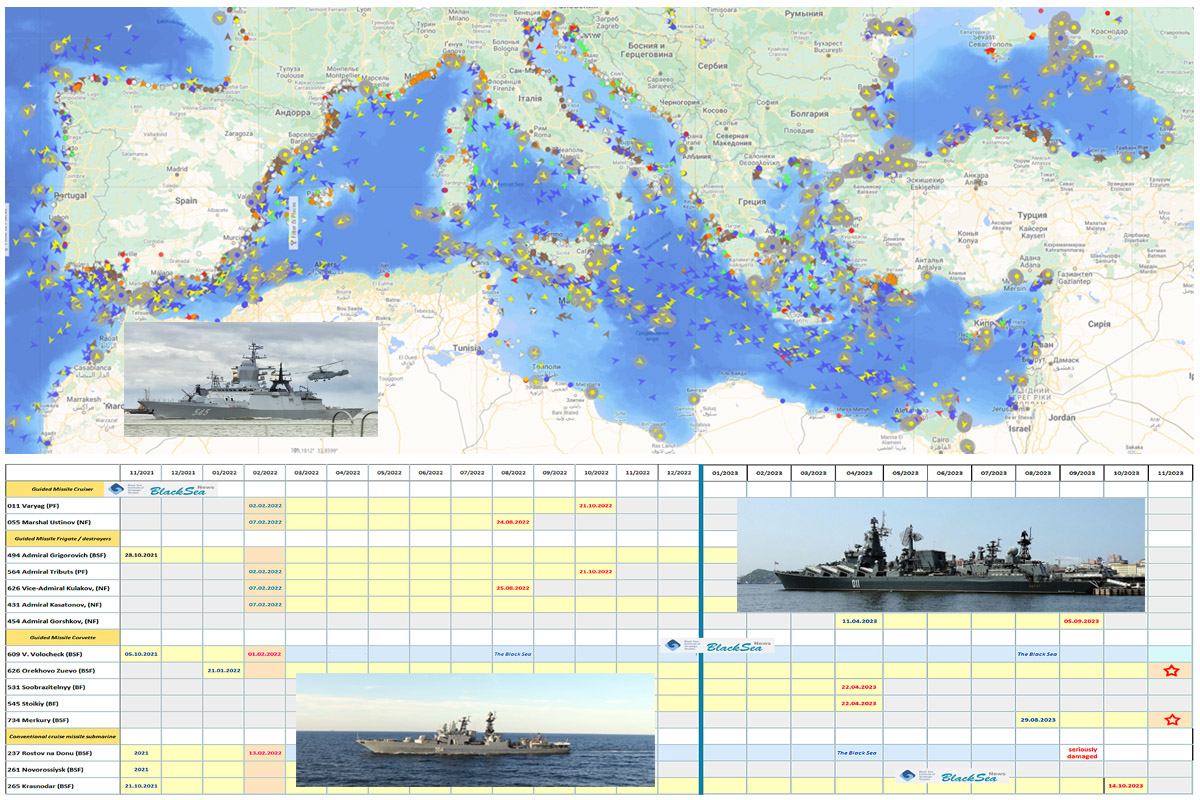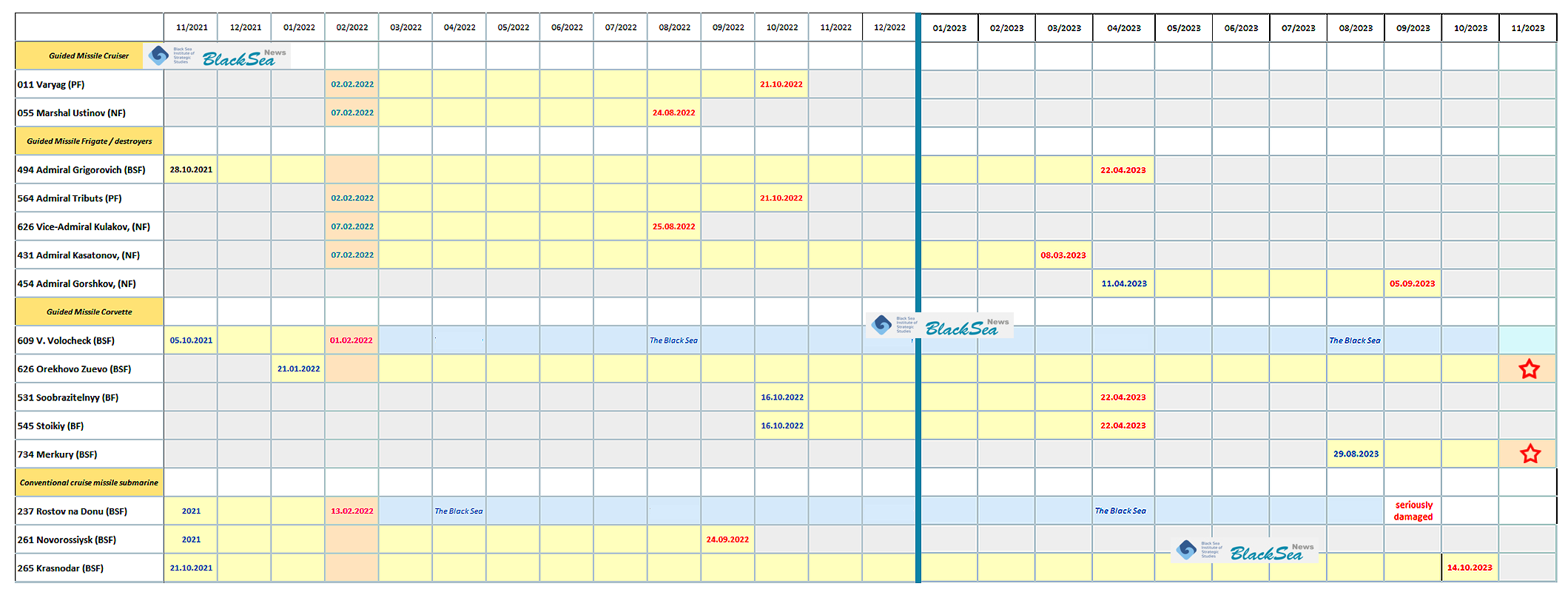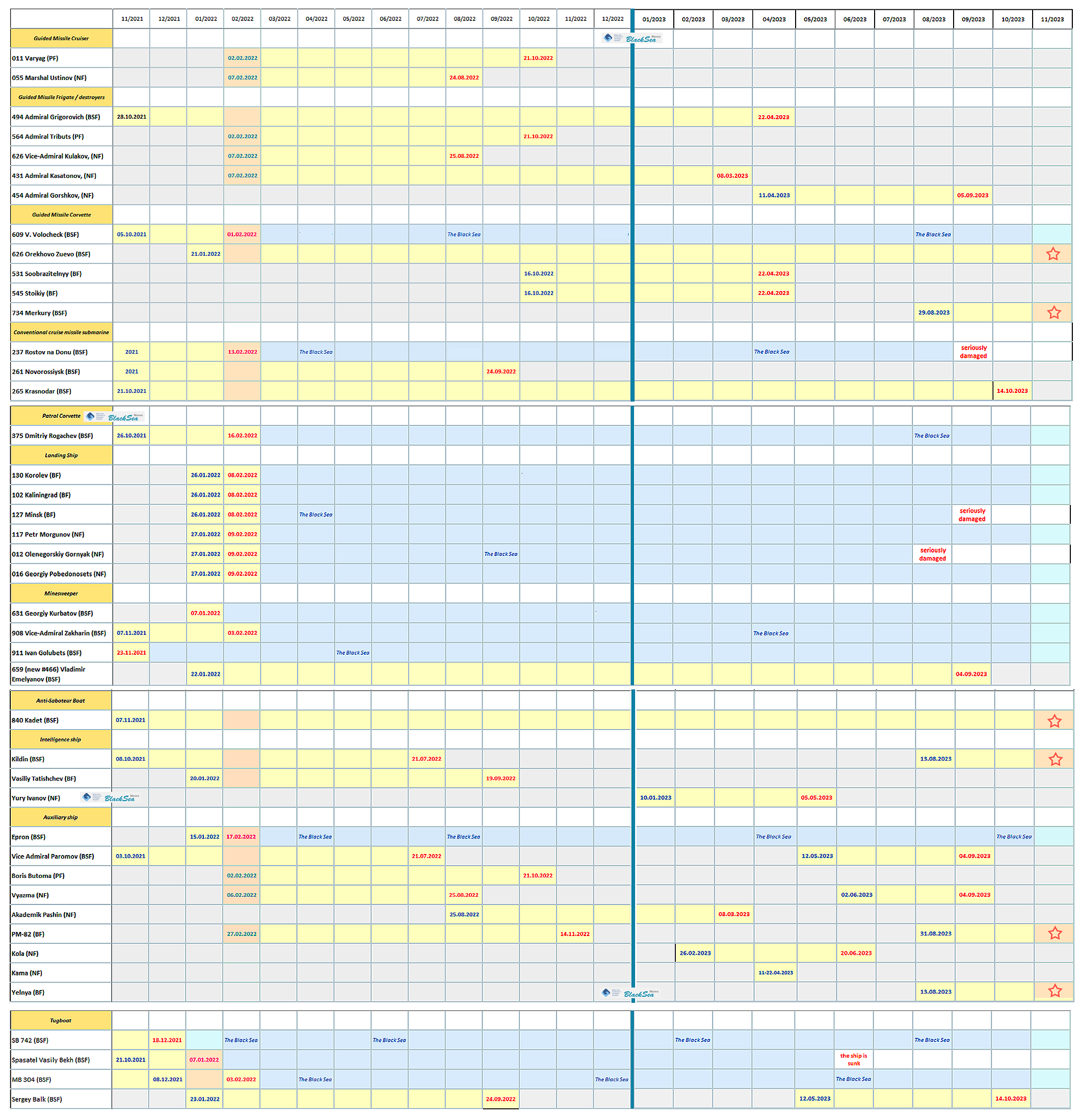Deployment of Russian Warships in the Mediterranean as of November 1, 2023

The Monitoring Group of the Black Sea Institute of Strategic Studies
and BlackSeaNews
The Monitoring Group of the Black Sea Institute of Strategic Studies and BlackSeaNews, based on the results of its own monitoring (see Tables 1-3), presents the database of the deployment of the Russian Naval ships in the Mediterranean Sea between November 2021-November 2023.
Summary
In 2022-2023, the composition of the Russian naval grouping in the Mediterranean Sea has undergone dramatic changes.
Just before the large-scale attack on Ukraine on February 24, 2022, Russia had formed in the Mediterranean Sea an unprecedented grouping of warships from all four of its fleets. Specifically, in the first decade of February 2022, Russia's «Mediterranean squadron» included 29 ships and boats, specifically: 11 missile ships, 6 large amphibious assault ships (LST), a patrol corvette, 2 minesweepers, an anti-submarine warfare boat, 2 reconnaissance ships, 4 auxiliary supply vessels, and 2 tugs.
However, Turkey’s February 27 decision to ban the passage of any Russian warships, including those of the Black Sea Fleet (BSF) on their way back to their home port, through the Bosphorus and Dardanelles, led to the grouping being virtually trapped, with no sense of being there, except for the so-called flag demonstration.
In addition, after the outbreak of the Great War against Ukraine on February 24, Russian warships lost the option of making repair calls in the EU states Mediterranean ports, while plans to transfer one of the floating docks from the BSF to Tartus in 2022 have not materialized. At the same time, the ship repair capabilities of the floating naval shipyard located in Tartus on a rotational basis are limited, especially for large ships, most of which were built in the Soviet era and require frequent repairs..
In the late summer of 2022, Russia began a gradual withdrawal of its main warships from the region. As of October 15, 2023, the number of Russian Mediterranean grouping has decreased by 5 times — from 29 ships and boats in February 2023 to merely 6 in October 2023.
Currently it includes: 2 missile corvettes, an anti-submarine warfare boat, a reconnaissance ship, a supply tanker, a floating shipyard, and not a single tug.
It is therefore logical to assume that Russia no longer considers the prospect of the group’s passing through the Turkish Straits realistic, and thus, has given up the plans for active operations in the northern and northwestern part of the Black Sea.
Meanwhile, the number of existing Russian naval forces and munitions in the region is still completely sufficient to protect their bases, launch missile strikes against Ukraine, and conduct reconnaissance activities in the southwestern part of the Black Sea.
Report
In 2022-2023, the composition of the Russian naval grouping in the Mediterranean Sea underwent dramatic changes.
Table 1: Deployment of missile ships of the Russian Navy «Mediterranean squadron» in the Mediterranean Sea from November 2021 to November 2023. (Table legend is provided at the end of the text, before Table 3).

Just before the large-scale attack on Ukraine on February 24, 2022, Russia had formed in the Mediterranean Sea an unprecedented grouping of warships from all four of its fleets.
Specifically, in the first decade of February 2022, Russia's "Mediterranean squadron" included 29 ships and vessels: 11 missile ships, 6 large amphibious assault ships (LST), a patrol corvette, 2 minesweepers, an anti-submarine warfare boat, 2 reconnaissance ships, 4 auxiliary supply vessels, and 2 tugs.
The main reasons for the group formation were:
- replacing the ships of the Russian BSF that had been returned to the Black Sea a few weeks prior to February 24, 2022
- potential participation in a war against Ukraine in the Black Sea
- creation of a demonstrative counterweight to NATO naval groups in the Mediterranean
The main purpose of creating such a powerful grouping was to use most of its ships in the war against Ukraine directly in the Black Sea theater.
The naval group’s objectives included :
-
providing support to the Russian ground offensive
-
launching missile strikes on critical civilian and military infrastructure
-
destruction of the entire potential of the Ukrainian Navy
-
blockade of maritime communications around Ukraine and possible activities of the navies of NATO Black Sea member states, and preventing ships of other NATO member states, such as the US, from entering Russian zone of their interests around Ukraine
-
making it impossible for NATO member states to conduct intelligence activities by closing the western and northwestern regions of the Black Sea under false pretexts
-
participation in the amphibious operation in the southern regions of Ukraine, namely, Odesa and Mykolaiv regions
-
maintaining control over the oil and gas infrastructure in the northwestern and western parts of the Black Sea
-
ensuring the logistics security for Russia’s military contingent in Syria
The advance presence of a large Russian combined fleet group in the Mediterranean Sea allowed for the maximum withdrawal of the BSF warships from the Mediterranean to the Black Sea by February 24, 2022 for participation in the offensive.
Table 2. Deployment of amphibious, patrol and minesweeping ships of the Russian Navy «Mediterranean squadron» in the Mediterranean Sea from November 2021 to November 2023. (Table legend is provided at the end of the text, before Table 3).

On February 8-9, 2022, all 6 Russian Baltic and Northern Fleet Landing Ships entered the Black Sea from the Mediterranean at once.
Thanks to Ukraine's diplomatic activity and Turkey's position, that has become the last redeployment of Russian warships to the Black Sea.
Turkey’s closure of its straits has effectively destroyed Russia's plans to take control of the entire Black Sea around Ukraine and occupy its southern regions.
On February 28, 2022, Turkey announced that it had closed the Bosphorus and Dardanelles straits in accordance with the 1936 Montreux Convention, which prohibits the passage of warships of belligerent countries through the straits.
Turkish Foreign Minister Mevlut Cavusoglu said: «Russia has announced that four of its ships will cross the straits on February 27-28, three of which are not registered at bases in the Black Sea. We told Russia not to send these ships, and Russia said that the ships would not cross the straits.»
According to the Monitoring Group, the ships in question were: large anti-submarine ship (564) Admiral Tributs, Russian Pacific Fleet (PF), Udaloy-class guided-missile destroyer; large anti-submarine ship (626) Vice-Admiral Kulakov, Russian Northern Fleet (NF), Udaloy-class guided-missile destroyer; missile frigate (431) Admiral Kasatonov, Northern Fleet of the Russian Federation (NF), Admiral Gorshkov class frigate or missile frigate (494) Admiral Grigorovich, (BSF), guided missile frigate Krivak V-class and reconnaissance ship Kildin (BSF) or Vasiliy Tatishchev (BF).
It should be noted that Turkey's decision was made as a result of strong diplomatic pressure from Ukraine. According to our data, on the first day of the Russian attack — February 24, 2022 — the Ukrainian Embassy in Ankara sent several firm notes demanding an immediate ban on the movement of Russian warships through the Turkish straits.
Nevertheless, in February 2022, Russia managed to form an unprecedented grouping of large amphibious assault ships (LAS) in the Black Sea.
It consisted of 13 vessels — 7 LSTs of the BSF, one of which was under repair at the time, and 6 «visiting» ones. It was due to that that Russia was able to demonstrate amphibious operations in the Black Sea and the Sea of Azov, even though it actually has conducted none.
However, the fact that Russia failed to deploy additional powerful missile surface ships to the Black Sea made the effectiveness of a possible amphibious operation on the Ukrainian Black Sea coast dubious, making the success of the ground forces its only hope.
Meanwhile, as a result of the Turkish straits closure and due to the fact that on April 23, Turkey announced it would close its airspace to Russian military and civilian aircraft heading to Syria, Russia started experiencing great difficulties in supplying its military bases in Syria.
Besides, Turkey’s February 27 decision to ban the passage of any Russian warships, including those of the Black Sea Fleet (BSF) on their way back to their home port, through the Bosphorus and Dardanelles, led to the grouping being virtual trapped, with no sense of being there, except for the so-called flag demonstration.
As after February 24, the «Syrian Express» — the already traditional method of using LSTs from Russia’s Black Sea ports for supplying its Mediterranean naval group — became impossible, now civilian tankers and ro-ro ferries are being used instead.
In addition, after the outbreak of the Great War against Ukraine on February 24, Russian warships lost the option of making repair calls in the EU states Mediterranean ports,.
while plans to transfer one of the floating docks from the BSF to Tartus in 2022 have not materialized. At the same time, the ship repair capabilities of the floating naval shipyard located in Tartus on a rotational basis are limited, especially for large ships, most of which were built in the Soviet era and require frequent repairs.
In the late summer of 2022, Russia began withdrawing some of its main warships from the Mediterranean.
Over August-October 2022, Russia withdrew 5 missile ships from the Mediterranean Sea: missile cruisers Varyag (PF) and Marshal Ustinov (NF), as well as missile destroyers Admiral Tributs (PF) and Vice-Admiral Kulakov (NF) — all built in the Soviet era (1980s) — and the Novorossiysk (BSF) missile submarine.
To compensate somewhat for the withdrawal, in October 2022, Russia redeployed 2 missile corvettes of the Baltic Fleet — Soobrazitelnyy (BF) and Stoikiy (BF) — to the Mediterranean, where they remained for 6 months before being called back at the end of April 2023. At the same time, in April 2023, after 18 months of deployment, the Black Sea Fleet missile frigate Admiral Grigorovich (BSF) was deployed to the Baltic Sea. A month earlier, in March 2023, the missile frigate Admiral Kasatonov (NF), the last of the warships to arrive in the Mediterranean before the war, returned to its NF base after 14 months of deployment.
In turn, to compensate for the March-April 2023 withdrawal of those 4 missile ships, the NF missile frigate Admiral Gorshkov arrived in the Mediterranean in mid-April.
So, by May 2023, the number of missile ships in the Russian «Mediterranean squadron» had decreased to 3 — the smallest number since February 2022 — making it at most a heterogeneous flotilla consisting of: a missile frigate, a missile corvette and the missile submarine Krasnodar (BSF), as well as a reconnaissance ship, a minesweeper, a sabotage boat, a tanker, and a tugboat.
In August-September 2023, the missile frigate Admiral Gorshkov (NF), was replaced by a new missile corvette Merkury (BSF), built in St. Petersburg for the BSF and commissioned to it only in May 2023.
Finally, in September-October 2023, the BSF ships, the Krasnodar missile submarine and the Vladimir Emelyanov minesweeper, that had been in the Mediterranean for 24 and 20 months, respectively, were withdrawn from the Mediterranean to the Baltic Sea.
Thus, as of October 15, 2023, the number of the Russian Navy ships in the Mediterranean Sea has decreased by 5 times — from 29 ships and boats in February 2023 to 6 in October 2023.
Currently those include: 1) missile corvette Merkury (BSF); 2) missile corvette Orekhovo Zuevo (BSF); 3) anti-submarine boat Kadet (BSF); 4) reconnaissance ship Kildin (BSF); 5) tanker Yelnya (BF); 6) floating ship PM-82 (BF).
All of the above may indicate that:
Russia no longer considers the prospect of the group’s passing through the Turkish Straits realistic, and thus, has given up the plans for active operations in the northern and northwestern part of the Black Sea.
Meanwhile, the number of existing Russian naval forces and munitions in the region is still completely sufficient to protect their bases, launch missile strikes against Ukraine, and conduct reconnaissance activities in the southwestern part of the Black Sea.
* * *
Appendix 1. Full list of ships and boats of the «Mediterranean squadron» of the Russian Navy in February 2022 before the start of a large-scale attack on Ukraine.
Abbreviations:
PF – Russian Pacific Fleet, NF – Russian Northern Fleet, BSF – Russian Black Sea Fleet, BF – Russian Baltic Fleet.
The names of ships and boats, as well as their classification, are given in NATO terminology. The names of ships are preceded by their tactical numbers.
Guided Missile Cruiser - Ракетний крейсер
-
011 Varyag (PF)
-
055 Marshal Ustinov (NF)
Guided Missile Frigate / destroyers - Ракетний фрегат / есмінець
-
494 Admiral Grigorovich (BSF)
-
564 Admiral Tributs (PF)
-
626 Vice-Admiral Kulakov, (NF)
-
431 Admiral Kasatonov, (NF)
Guided Missile Corvette - Ракетний корвет
-
609 V. Volocheck (BSF)
-
626 Orekhovo Zuevo (BSF)
Conventional cruise missile submarine - Ракетний підводний човен
-
237 Rostov na Donu (BSF)
-
261 Novorossiysk (BSF)
-
265 Krasnodar (BSF)
Patrol Corvette - Патрульний корвет
-
375 Dmitriy Rogachev (BSF)
Landing Ship - Великий десантний корабель
-
130 Korolev (BF)
-
102 Kaliningrad (BF)
-
127 Minsk (BF)
-
117 Petr Morgunov (NF)
-
012 Olenegorskiy Gornyak (NF)
-
016 Georgiy Pobedonosets (NF)
Minesweeper - Мінний тральщик
-
908 Vice-Admiral Zakharin (BSF)
-
659 (new #466) Vladimir Emelyanov (BSF)
Anti-Saboteur Boat - Протидиверсійний катер
-
840 Kadet (BSF)
Intelligence ship - Розвідувальний корабель
-
Kildin (BSF)
-
Vasiliy Tatishchev (BF)
Auxiliary ship - Допоміжне судно
-
Epron (BSF)
-
Vice Admiral Paromov (BSF)
-
Boris Butoma (PF)
-
Vyazma (NF)
Tugboat - Буксир
-
MB 304 (BSF)
-
Sergey Balk (BSF)
* * *
Table 3: Deployments of ships and vessels of all types of the Russian Navy in the Mediterranean Sea from November 2021 to November 2023
Abbreviations:
PF – Russian Pacific Fleet, NF – Russian Northern Fleet,
BSF – Russian Black Sea Fleet, BF – Russian Baltic Fleet.
The names of ships and boats, as well as their classification, are given in NATO terminology.
The names of ships are preceded by their tactical numbers.
The cell date colors indicate:
Yellow – stay in the Mediterranean Sea
Blue – arrival to the Mediterranean Sea
Red – departure from the Mediterranean Sea.

* * *
 This article has been prepared with the support of the European Union in Ukraine. The content of the article is the sole responsibility of the authors and does not necessarily reflect the position of the EU
This article has been prepared with the support of the European Union in Ukraine. The content of the article is the sole responsibility of the authors and does not necessarily reflect the position of the EU
More on the topic
- 31.05.2023 Deployment of Russian Warships in the Mediterranean as of May 31, 2023
- 06.11.2022 The presence of Russian warships in the Mediterranean Sea as of 6 November 2022
- 12.10.2022 The Presence of Russian Warships in the Mediterranean Sea as of 10 October 2022
- 16.09.2022 The Presence of Russian Warships in the Mediterranean Sea as of 15 September 2022
- 11.05.2022 The Presence of Russian Warships in the Mediterranean Sea as of 10 May 2022
- 09.03.2022 The Presence of Russian Warships in the Mediterranean Sea as of 9 March 2022
- 15.02.2022 Increased Risks. Obstruction of Traffic in the Black and Azov Seas by Russia due to the Closure of Sea Areas for Military Exercises as of 15 February 2022
- 01.02.2022 The Presence of Russian Warships in the Black Sea and the Mediterranean Sea in January 2022
- 20.12.2021 International Security Risks in the Azov-Black Sea Region in November-December 2021